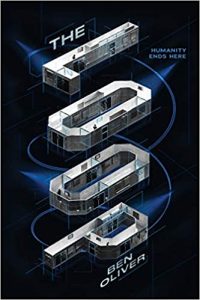Gary K. Wolfe reviews Christopher Priest
It takes a bit of triangulation to arrive at the core of Christopher Priest’s endlessly tantalizing and ultimately very satisfying The Adjacent, and some of that triangulation is quite literal: characters, events, and places are doubled and tripled, and the central apocalyptic images are areas of land in which everything has been obliterated, leaving only perfect equilateral triangles of blackened earth, the result of a mysterious new weapon which is the novel’s most flamboyant SFnal invention. Even the title has multiple meanings – as the mechanism through which the new weapon operates (allegedly by somehow displacing things into a neighboring quantum realm), as a technique of misdirection employed by stage illusionists, as a huge overcrowded shantytown on an island in Priest’s Dream Archipelago (whose appearance late in the novel is only the most radical move of a novel choreographed in unexpected moves). At times it’s reminiscent of the kind of generation-hopping linked narratives of a Michael Cunningham or David Mitchell, but mostly it echoes Priest’s own earlier preoccupations with stage illusions (The Prestige), possible alterities of WWII (The Separation), imaginary geography (The Islanders), and even the sort of post-apocalyptic dystopian England that he explored as far back as Fugue for a Darkening Island.
We meet the first version of our protagonist, the photographer Tibor Tarent, as he returns from Turkey, where his wife Melanie was obliterated by what we soon recognize as an adjacency weapon, leaving behind those blackened triangles. A much larger triangle has annihilated a good chunk of London, and when Tibor witnesses such a weapon in action, it’s described with a special-effects glee worthy of Independence Day. But these attacks are not all that has turned this future England – now part of the Islamic Republic of Great Britain – into a virtual police state: violent ‘‘temperate storms’’ ravage the landscape periodically, and armed gangs roam the countryside. After an uneasy reunion with Melanie’s parents and some Kafkaesque debriefings, Tarent is summoned to an area called Warne’s Farm, but en route has a brief encounter with a secretive woman who calls herself Flo and works for the government in an unspecified capacity, who later seems to die in another adjacency attack.
The second iteration of TT takes us back to WWI, when a stage illusionist named Tommy Trent, in a scheme that sounds like a Wodehouse parody, is drafted by a military officer who seems to think his skill at disappearing things on stage can somehow be translated into making British aircraft invisible to the Germans. En route, he finds himself in conversation with H.G. Wells – the middle-aged, more cynical Wells who had just published The War that Will End War. Trent wonders if the illusionist’s trick of adjacency – placing two objects near each other and calling attention to one as a kind of misdirection – might work, but finally despairs of any thought of success and returns to London. A brief interlude takes us back to the 21st century, where a journalist named Jane Flockhart recounts an interview with the physicist who invented the adjacency field, which can ‘‘divert physical matter into a different, or adjacent, realm’’ and who naively believed his discovery could never be weaponized, echoing Wells’s dream of ending war. (The photographer accompanying her on the assignment is a younger Tibor Tarent.)
We next find ourselves in a WWII British airfield (which, we eventually realize, will later be Warne’s Farm), where an aircraft mechanic named Torrance finds a wallet left behind in a plane by Krystyna Roszca, a skilled aviator whose tale of her early romance with a young man named Tomasz and her eventual escape from Poland takes up much of the chapter. Decades later, though, a much older Torrance can find no trace that Krysyna or Tomasz ever existed. Back in the 21st century, trapped by the violent storms at Warne’s Farm, Tarent becomes involved with yet another woman, a teacher named Lou, who tells him that England is facing ‘‘the last war ever, the war that will end everything’’ – again echoing Wells’s words from back in 1914. He also is asked to identify the body of a Dr. Mallinen, who turns out to be Flo, but by now his own reality is splintering into parallel streams, in which Flo might still be alive, or in which he himself may be dead, or both. A recurrent image of a brick tower on the site of the airfield that later becomes the farm begins to take on something of the aspect of a Childe Roland dark tower, and seems to be involved in some way with the discovery of the adjacency principle itself.
But what seems to be the most unexpected shift of all – away from England entirely to the island of Prachous in the Dream Archipelago – instead turns out to be the portion of the novel in which the various guylines begin to be gathered together. We meet another TT, a photographer named Tomak Tallant – whose journey across the desert with a mysterious woman missionary recalls Tarent’s journey across England with the equally mysterious Flo – and yet another, a stage magician named Thom the Thaumaturge, whose main trick goes horribly awry. We also meet another version of the aviator Krystyna Roscza, now called Kirstenya Rosscky, who changes her name to Mellanya Ross (which of course echoes both Melanie and Mallinen). By now it’s becoming clear that the reader has some assembly work to do – sometimes a Priest novel feels like something you’ve just unpacked from Ikea and are wondering if all the tools have been included – but Priest’s clever manipulation of his own adjacencies somehow makes the novel grow more coherent even as it grows more mysterious. In some ways a contrapuntal intergenerational love story, in some ways a meditation on war and remembrance, in some ways an exploration of the nature of illusion and observation (it’s no accident there are so many reporters, photographers, and illusionists here), it is, overall, rather stunning.







